There’s a solid reason why the Golden Retriever dog is one of the world’s most popular dog breeds. This dog is also well-liked for its pleasant demeanor and high intelligence and loyalty, making it an excellent companion for people from all walks of life. Whether you already have a Golden in your home or are thinking about getting one, you’ll find helpful information in this article from Canvas Personalized.
1. Golden Retriever Dog Breed Information
| Origin | Scotland | Good With | Families, children, cats, and other dogs |
| Dog Breed Group | Sporting dogs | Temperament | Gentle; friendly; willful; outgoing and playful |
| Common nicknames | Flat-coated Retriever | Energy Level | Active; High |
| Height | Male: 23-24 inches Female: 21.5-22.5 inches | Shedding | Frequent |
| Weight | Male: 65-75 lbs Female: 55-65 lbs | Tendency to Drool | High |
| Coat | Double coat, dense and water-repellent | Snore | High |
| Color | Any shade of gold or cream | Bark | When necessary |
| Life span | 12-13 years | Training | Easy to train and eager to please |
| Other traits | Tendency to chew; high potential for weight gain; loves water; good for first-time pet owners and strong loyalty tendencies |
1.1. History

The Golden Retriever breed was developed by Sir Dudley Marjoribanks, a dog enthusiast who favored yellow retrievers. In 1865, he acquired a yellow dog called Nous and bred him with a liver-colored Tweed Water Spaniel.
Over the next two decades, he continued breeding, introducing Labrador Retrievers, Red Setters, and possibly even Bloodhounds to refine the breed’s scenting abilities and add bone structure. By 1908, these efforts resulted in a new breed, initially shown as “Golden Flatcoats.” The name evolved over time, becoming “Yellow or Golden Retrievers” in 1913 and finally settling on the familiar breed name “Golden Retriever” in 1920.
This breed received official recognition from the American Kennel Club (AKC) in 1925 and has since become one of the most popular dog breeds in the United States.
1.2. Golden Retriever Appearance
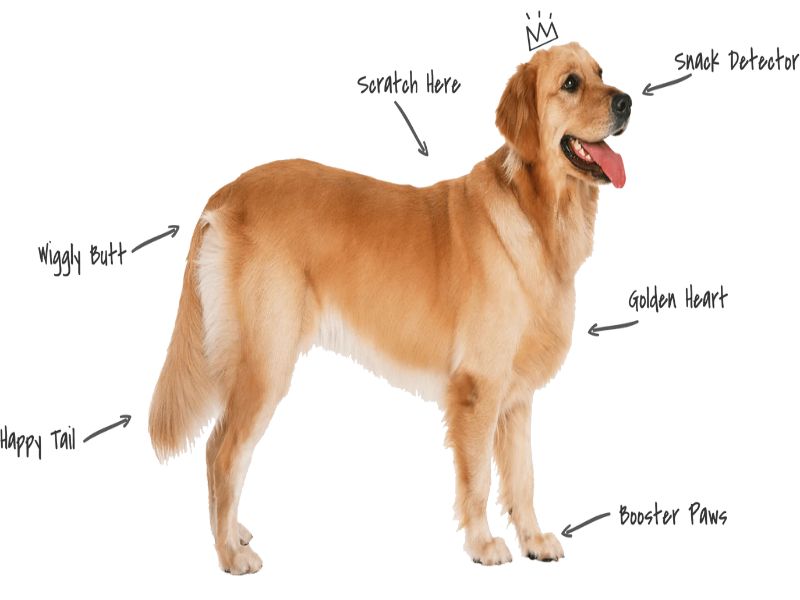
Don’t let the name fool you! They come in a beautiful spectrum of golden coat hues! From the light and creamy tones of the English Cream Golden Retriever to a richer, darker gold, their fur is truly stunning. These playful pups have adorable feathers on their legs, chest, and tail, making them look even more charming. And with their long, floppy ears that flop around as they play, Golden Retrievers truly embody the spirit of a puppy.
Side Notes
If you’re looking for a purebred Golden Retriever, be aware the Golden Minis. They’re known for their adorable, puppy-ish appearance. But unlike a true Golden Retriever, a mini Golden Retriever is actually a mix of other breeds.
1.3. Golden Retriever Personality
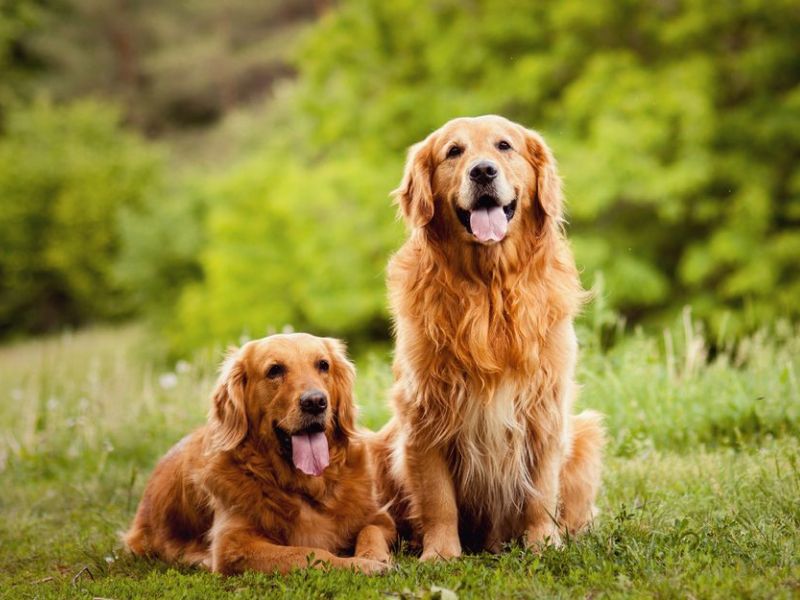
The Golden Retriever is a popular breed for several reasons, including intelligence, temperament, and level of affection. Like other retriever dogs like American pitbull terriers, or boxer dog breeds, this dog is calm and responsive to commands, making them simple to teach and eager to please their owner. It is typical of the species because it still has many traits and instincts of a gundog, such as a good sense of smell and a strong urge to retrieve.
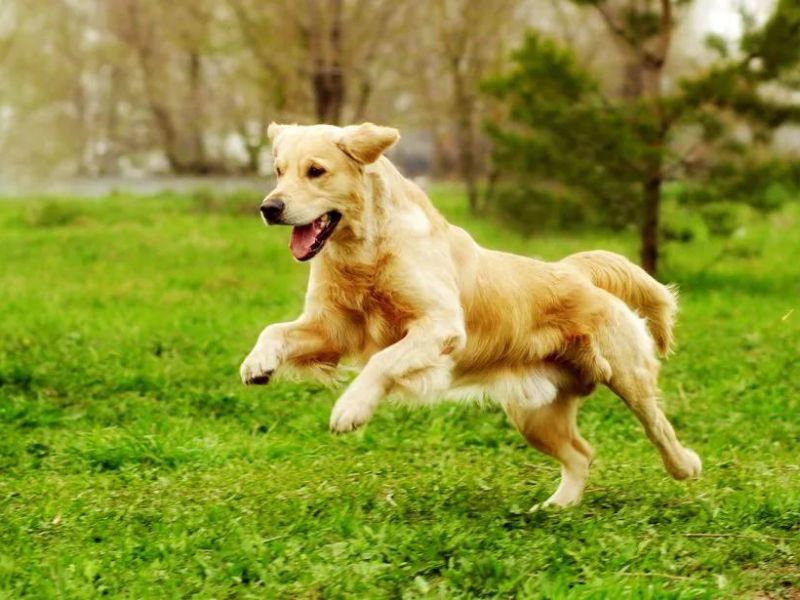
The golden was explicitly developed to assist humans; as such, it takes its role as a pet very seriously. The dog also gets along well with kids and other pets, including cats (Just to be safe, never leave your dog and young children together unsupervised!). Generally speaking, Golden Retrievers are excellent family dogs.
However, these gentle dogs are incredibly sensitive and crave companionship. While happy to play fetch or cuddle on the couch, they truly dislike being left alone for long stretches. The golden retriever dog breed is known for its kind demeanor, but unfortunately, this also means they are not the best guard dogs.
>>> Learn more about the chihuahua dog breed if you’re looking for the perfect companion for your family!
1.4. Female vs Male

As mentioned, male Golden Retriever adults tend to be slightly larger and heavier than their female counterparts. Some owners believe males are more cuddly companions while females are more independent. Females might not crave quite as much attention and may be less prone to separation anxiety, but these are tendencies, not guarantees.
Regardless of sex, Golden Retrievers are known for being affectionate and loyal. So, we believe that the best way to find your perfect Golden Retriever match is to meet the individual dogs and see who steals your heart!
2. Ideal Owner

Golden Retrievers are large dogs that need active owners to keep up with their playful spirit. These furry bundles of joy require daily exercise, up to an hour a day, and would love an energetic companion to join them on adventures.
Whether it’s swimming, running, walks in the park, or even a good game of fetch, Golden Retrievers crave playtime and interaction. Their active lifestyle and desire for family time make them a perfect fit for owners who share their love for the outdoors and have plenty of time to devote to their canine BFF.
Overall, Golden Retrievers are fantastic dogs for families who love outdoor activities. However, it’s essential to consider the pros and cons before bringing a new dog into your home.
| Golden Retriever Pros | Golden Retriever Cons |
| Calm, friendly nature | Often hungry, needs a lot of food to stay satisfied |
| A good family dog (good with people, children, and other pets) | Sheds a lot |
| Very playful | Not good at being left alone all day |
Dogs with high energy levels require plenty of exercise to maintain their overall well-being, while low-energy dogs have lower exercise requirements. So, when choosing a dog, consider its energy levels and how they align with your lifestyle.
After contemplating all these things, is your heart still set on this furry friend? If so, continue reading; the following will tell you what to expect when having a Golden Retriever as your new family member.
3. How to Take Care of a Golden Retriever Dog?
3.1. Health Issues
Golden Retrievers is one of the healthiest dog breeds, but like every dog, Golden Retrievers are prone to certain health conditions like hip dysplasia and cancer. While a Golden Retriever adult tends to be healthy overall, it’s essential to make sure that your dog’s parents have been checked for specific health issues like elbow and hip dysplasia, eye issues (cataracts, uveitis, progressive retinal atrophy), and heart conditions (aortic stenosis).
Regular veterinary examinations and screenings are essential to diagnose and prevent health problems, especially as your dog ages. Here are the health tests recommended by the American Kennel Club (AKC) and the National Breed Club:
- Hip Evaluation
- Neuronal Ceroid Lipofuscinosis 5 (Golden Retriever) (NCL, NCL5) – DNA Test
- Elbow Evaluation
- Cardiac Exam
- Ophthalmologist Evaluation
3.2. Golden Retriever Grooming
- Grooming
Golden Retrievers are moderate shedders year-round, with heavy shedding seasons in spring and fall. Living with a Golden Retriever means getting used to a certain amount of dog hair in your home and on your clothes. Their double coat also requires regular brushing to maintain its health and minimize shedding.
Brushing with a slicker brush once or twice a week should be enough to remove most of the dead hair before it settles into your interiors. If shedding is particularly intense, these brushing sessions become daily rituals. The Golden Retriever also benefits from a bath every month or two to help remove dust and debris, as well as to manage dead hair.
- Nail care
Like most dogs, Golden Retrievers require regular nail trims to maintain their paw health and prevent discomfort. Active dogs who get regular walks on sidewalks or other abrasive surfaces will have their nails naturally ground down, reducing the need for frequent clipping. However, if your Golden Retriever primarily walks on soft surfaces like grass or dirt, their nails won’t wear down as quickly. In this case, you can expect to trim their nails every two months or so.

- Oral care
Brushing your Golden Retriever’s teeth regularly is vital to keeping their mouth healthy. Aim to brush at least two to three times a week to remove tartar buildup and bacteria. If you want to keep gum disease and bad breath at bay, consider brushing daily!
- Ear care
Keeping your Golden Retriever’s ears healthy involves regular checks. Ideally, do this during bath time, but even more frequent checks are beneficial. Some pet owners incorporate ear checks into their dog’s brushing routine. This vigilance is especially crucial if your Golden Retriever enjoys swimming often. Bacteria in rivers, lakes, and other bodies of water can easily reach their warm, damp ear canals and lead to infection.
3.3. Exercise Needs
Like other sporting dog breeds, a Golden Retriever is an active dog who needs long daily walks (expect to 90 minutes/day). They enjoy being active through hunting trips, field trials, and various dog sports like agility, obedience, and tracking. While golden retrievers make excellent running and cycling partners, it’s essential to check with your vet before beginning any activity that could strain the dog’s bones and joints too much.

If you’re raising a Golden puppy, you need to pay extra attention to its health and development. These dogs grow quickly between the ages of four and seven months, leaving them prone to bone diseases. So, until your dog is at least two years old and his joints have fully developed, you shouldn’t allow him to run and play on rigid surfaces like pavement. They can safely participate in puppy agility classes or play on the lawn.
3.4. Space Requirements
A Golden Retriever dog is happiest when he or she can explore the great outdoors. Long walks in nature are a perfect fit for their adventurous spirit. Given the size of the Golden Retriever, having access to a large backyard will most likely make them feel more comfortable. The good news is that they are adaptable! As long as they have access to some outdoor space, like a garden, and get plenty of daily exercise, they can thrive in smaller living spaces as well.
3.5. Training
Because of their high intelligence and eagerness to please their owners, Golden Retriever is considered an easy-to-train dog. Their willingness to learn makes them a perfect choice for first-time dog owners.
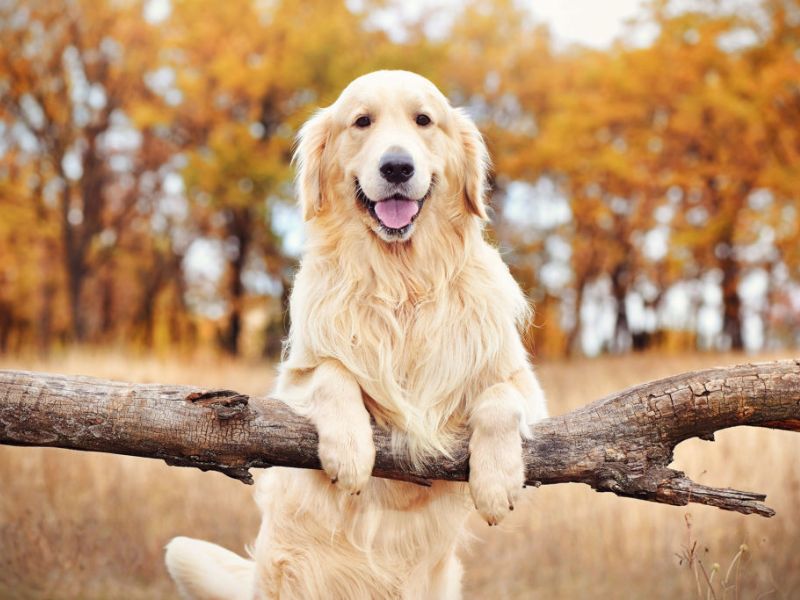
Golden Retriever puppies benefit greatly from early dog training and socialization programs, which can be achieved by exposing them to a wide range of experiences and environments. Moreover, they are brilliant and responsive to clicker training and other forms of positive reinforcement. So they are highly skilled at learning basic commands, such as how to sit, stay, play dead, or roll over, and are usually game for new challenges, making them excellent service dogs.
If you’re not confident teaching your dog on your own, enrolling your Golden Retriever puppy in puppy classes is a wise investment. These classes not only teach your pup essential commands but also equip you with the skills to continue effective training at home. Puppy classes are also a fantastic way to jumpstart your dog’s socialization with other people and dogs. Keep this socialization going at home during playtime, on walks, and even at dog parks. This will help your furry friend develop into a well-rounded and confident Golden Retriever adult.
>>> Check out these easy steps to crate train your new puppies, which are essential training tips you should know soon!
3.6. Diet and Nutrition
It’s important to remember that the amount of food your dog eats will vary depending on age, size, build, metabolism, and degree of activity. In the same way that not all humans have the exact caloric requirements, not all dogs have the same dietary needs. 2–3 cups of high-quality dry food each day, split between two meals, is the sweet spot for an adult Golden Retriever.

Moreover, keeping an eye on your Golden’s calorie intake and weight is vital because some breeds are more prone to obesity. Dog treats are great, but only in moderation. While treats can be an effective training tool, overdoing it can lead to excess weight. Treats should only make up about 10% of your dog’s daily food. Plus, it’s best to consult a vet to find out what kinds of human foods can be fed to your dog and what can’t.
A Golden Retriever dog can acquire food allergies, which might manifest as scratching and licking behavior. In many cases, a change in diet can help manage these problems; however, you should discuss this with your veterinarian first.
And don’t forget to make sure your dog always has access to fresh, clean drinking water, both day and night.
>>> Check out these dog food for skin allergies if your Golden has any allergy symptoms!
4. Getting a Golden Retriever Dog
4.1. Golden Retriever Puppy Price

Buying a Golden Retriever puppy can cost anywhere from $1,000 to $3,000 while adopting an adult dog costs between $200 and $500. They will run you between $2,000 and $3,000 the first year and then around the same every year after that. Everything from visits to the groomer and the vet to the cost of food and treats.
4.2. Golden Retriever Rescues
When searching for a puppy or adult dog, consider adoption first. Many Golden Retriever rescue dogs are waiting for loving homes through adoption or fostering programs. Most rescued dogs already have all the necessary vaccinations and have been spayed or neutered, unlike puppies. Plus, many dogs in shelters have been surrendered by their owners, so they may also be familiar with basic commands and have been socialized.
Here are some reputable organizations you might consider:
- Grateful Goldens Rescue of the Low Country (GGRLC)
- Delaware Valley Golden Retriever Rescue
- Homeward Bound Golden Retriever Rescue & Sanctuary
- Neuse River Golden Retriever Rescue (NRGRR)
If you can’t find a rescue near you, reach out to the national or local Golden Retriever Club, and they can connect you with a Golden Rescue in your area.
4.3. Golden Retriever Breeders

If you’re set on welcoming a puppy into your life, prioritize finding a reputable Golden Retriever breeder. A responsible breeder prioritizes the health and well-being of their dogs above all else. This means conducting thorough research to ensure the breeder follows ethical practices. This approach increases the chances you’ll bring home a healthy, happy Golden Retriever dog while discouraging unethical breeding practices prioritizing profit over dog health.
You can explore the fees of adopting a golden by contacting local breeders, shelters, and rescue groups. Before making a final decision, consider the ongoing costs of owning a dog, such as food, toys, grooming, and vet care.
>>> Get inspired by many beautiful country-themed names for your new puppies!
5. Golden Retriever Facts
5.1. They are excellent therapy dogs
Golden Retrievers are incredibly versatile service dogs, excelling in many roles except guard duty. Their friendly nature makes them less suited for protection work. However, their empathy and ability to sense human emotions shine in therapy settings. Golden Retrievers are often found in hospitals and other care facilities, providing comfort and emotional support to those in need. Their friendly spirit and attentiveness also make them well-suited to be guide dogs for the visually impaired.
5.2. They are naturally mouthy

Golden Retrievers may be stars in the service dog world today, but hunting was their original calling. Bred to retrieve birds shot by hunters, they excelled thanks to their attentiveness, love of water, and gentle carrying abilities that ensured the birds arrived undamaged. Today’s Golden Retriever is still into using its mouth to carry things, so be prepared to train your playful pup not to mistake your hand for a fetching object!
5.3. Super Sniffers
A Golden Retriever dog has an amazing sense of smell, over 200 times stronger than a human’s! This makes them excellent hunting companions, and they can even be trained for search and rescue work.
5.4. Treat Talkers
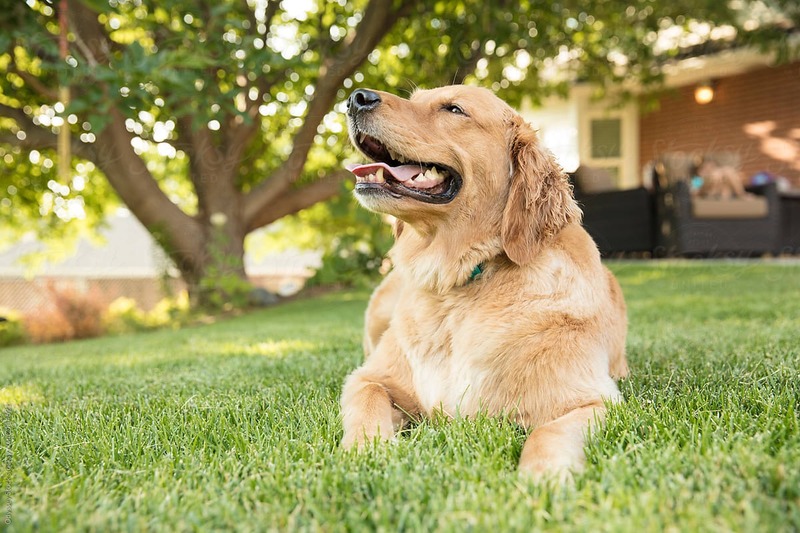
Don’t underestimate the intelligence of a Golden Retriever! These smart pups can be trained to understand a surprising number of words and commands. Some particularly clever Golden Retrievers can even be taught to “speak” for different treats – imagine a dog who barks once for a biscuit and twice for a belly rub!
>>> Further reading:
- Explore The French Bulldog Breed With Key Traits, Care, and Fun Facts
- Top 14 Types Of Doodle Dog Breed: The Ultimate Guide
- All About Aussiedoodle Dog: Traits, Health, and Caring
A Golden Retriever dog will deliver happiness, love, and companionship. Because of its welcoming nature, loyalty, and enthusiasm for exploring new places, this dog will make beautiful pets and friends for people of all ages. Hence, adopting a Golden Retriever will provide you and your family endless joy and excitement. Canvas Personalized hopes this article is helpful for you in finding out whether this breed of dog is appropriate for your family.










